We all know the feeling of wanting to quit our jobs, get out of the nine-to-five grind, and start a brand new venture.
It might be an inkling that comes and goes, or maybe it’s a desire you’ve had for years. Whatever the case, the idea of being totally in charge of a project, the hours you work, and where you work are some of the most enticing things about entrepreneurship.
In 2019, Mitchell Sandridge felt this same pull and eventually gave up a steady career working for an Australian charity to go all-in on ecommerce.
It wasn’t easy, but Mitchell was under no illusions that it would be.
Over the next 18 months, the Australian entrepreneur took a slow, careful approach that saw him scale a store to over $1 million Australian dollars, before shutting it down to get his business in order.
Mitchell has had some phenomenal success since starting in early 2019. But building one stand-out store was never his only goal. Instead, he’s put in time to create systems that can be replicated over multiple stores, giving him a solid foundation to build a suite of online brands.
We sat down with Mitchell to hear how he did and to learn some of his techniques.
Post Contents



Changing Careers and Going Full-Time on Ecommerce
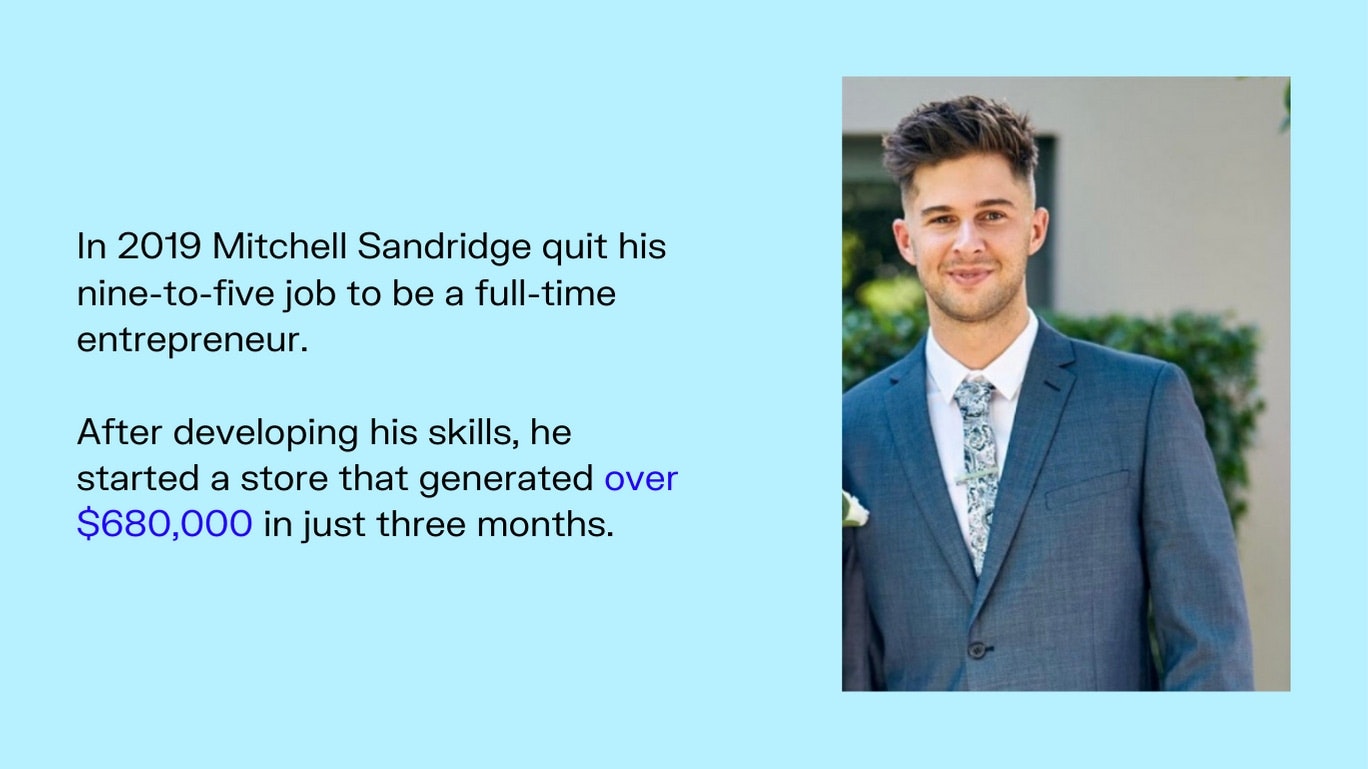
In early 2019, Mitchell lived in Sydney and worked a typical nine-to-five job in the fundraising team for the Heart Foundation of Australia.
→ Click Here to Launch Your Online Business with Shopify
Part of his job included managing a well-known fundraising initiative called Jump Rope for Heart. With schools all across the Australian participating in the program, his role involved a lot of travel.
With the monotony of the 40 hour work week wearing him down, Mitchell started using his spare time while traveling to look into alternative careers. After going down a YouTube rabbit hole, he came across dropshipping and began learning everything he could about ecommerce.
“I used that time to learn and develop my skills, and I slowly but surely built an online business.“
Mitchell’s first store – a niche store – sold small, home decor products. It was the perfect testing ground for the skills he’d picked up from videos and articles. The store had moderate success but also taught him some valuable lessons he was able to grow from.
“I had a bit of failure at first, obviously. I thought, ‘oh yeah, you can just put a product online, and that will sell.’ Obviously, that’s not the case. It does require a bit more work.”
“Once I started giving it more effort – actually putting the work in – that’s when I found some success.”
Finding Winning Products With Viral Potential
Mitchell used his first store to test everything from products to sales and marketing techniques. Although he says the store wasn’t much of a success in terms of profit, it allowed him to firm up his skills and paved the way for his second store.
Despite his store being in the home decor niche, Mitchell used it to test items from various categories that he believed could be winning products. Rather than searching for winning products that other dropshippers were already selling, he took a very different approach, which led to him finding an unexpected winning product.
“My approach to product searching and testing is, I look for products that have the potential to go viral and have a wow factor. I saw [his winning product] on AliExpress… There weren’t too many orders actually, so it hadn’t been tested before. They weren’t in much demand. And I thought, ‘Oh, you could make a pretty cool video of this.’”
He immediately put the item, which is from the children’s clothing category, on his home decor store and tested some ads. Soon the sales started rolling in and he knew he was onto something.
“Once I saw I was getting sales with that, I’m like, ‘This actually has potential!’”
With his product a proven winner, he focussed his energy on building a dedicated one product store that he knew would convert better.
Immediate Success and Scaling
Mitchell launched his one product store in September 2019, and pretty soon, it was apparent that this store would be more successful than his first.
Mitchell’s a big believer that original content sets a store up for success in both the short and long term. This feeds back into his belief that a winning product needs to have the potential to go viral within the target market. When he started his one product store, Mitchell made an effort to get a lot of original content.
“I think one of the biggest reasons for my success was just creating original footage. So I would hire influencers and also people from Fiverr who I would send the product, and they could film footage for me. And that way, people on Facebook that haven’t seen it before, it catches their attention.”
By using photos and videos created especially for his store, Mitchell established his brand as the go-to store for this product, making it hard for the copy-cats that would inevitably follow. This included things like setting up email funnels and using well-branded emails to keep the store on customer’s radars.
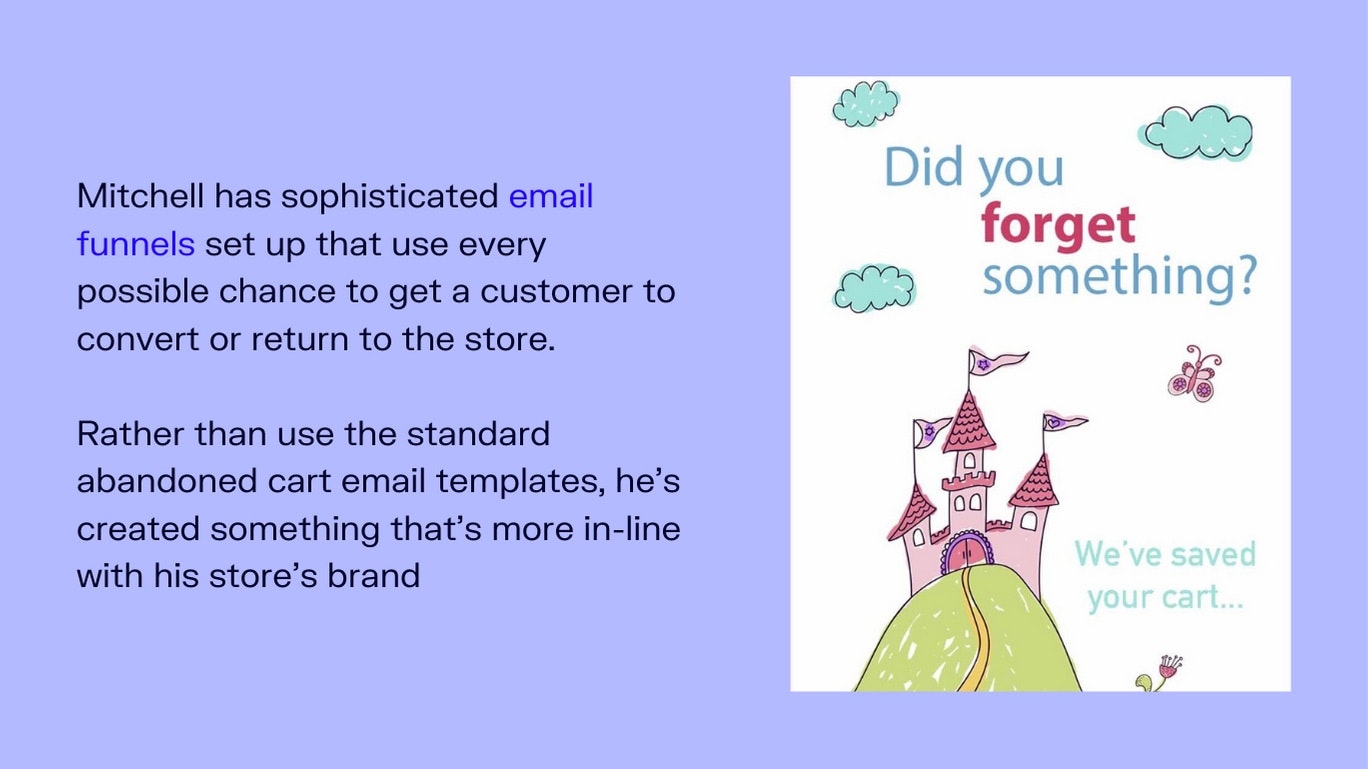
Mitchell continued scaling the store throughout October 2019, and by the time it reached November, things got crazy.
Massive Success Exposes Problems
In the lead up to Black Friday, Mitchell’s store had some monumental moments.
On November 9, the store had its biggest day, making over $17,500 in sales and leaving Mitchell with around $3500 in profit from just 24 hours of work – or around $4700 in Australian dollars.
The success and money were more than Mitchell could’ve hoped. When he’d started, he was hoping to make $100 in profit a day.
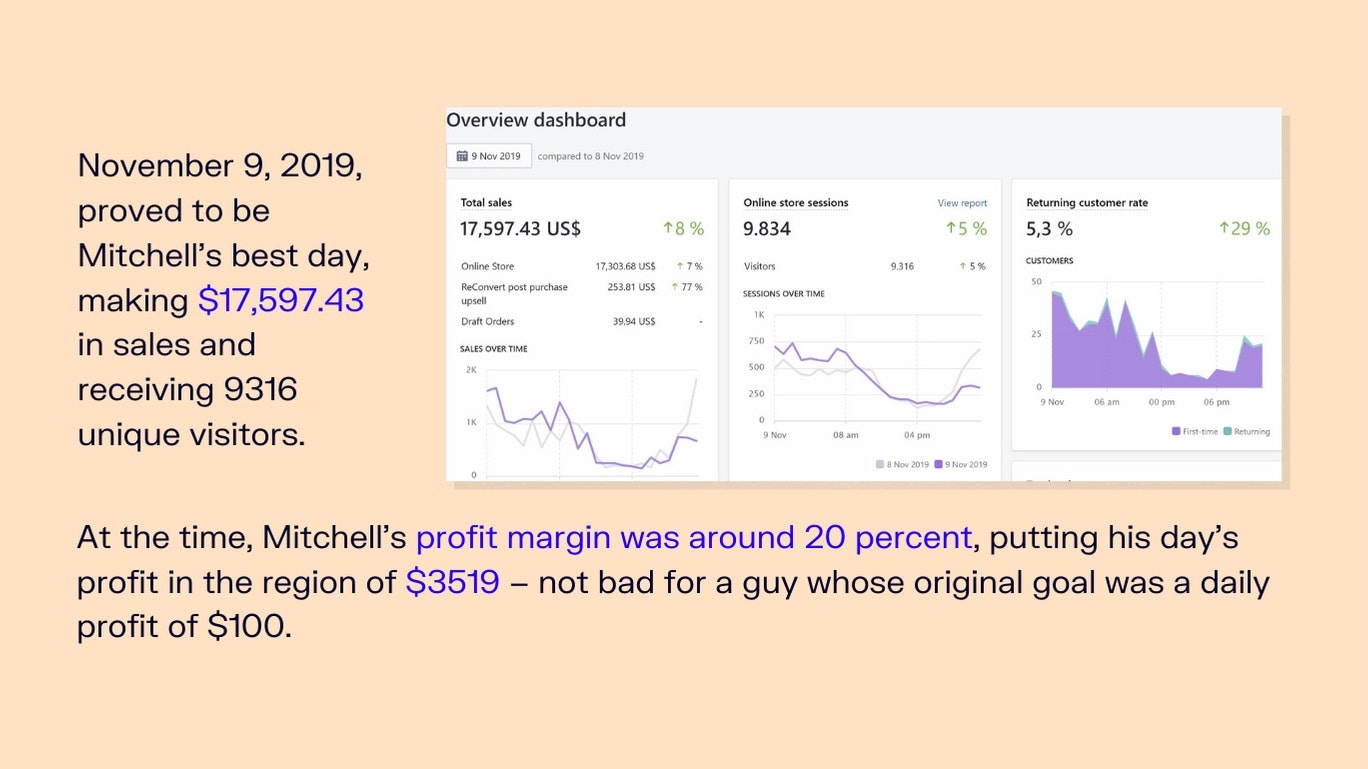
Mitchell continued scaling and prepared for a massive four days between Black Friday and Cyber Monday. He secured an agent who sped up the processing time, but with 300 orders a day it had become a big operation. The massive popularity of the product exposed weak points in his business.
“[The store] really took off in November. And I was also having a lot of issues through Facebook ads and suppliers.”
Mitchell considered bulk ordering products and sending them to a fulfillment center in the US to minimize shipping times for his customers, but it was too late by that stage. He wanted to avoid disasters and wanted to keep the momentum he had gathered. Unfortunately, it just wasn’t possible.
Many of the products ordered over Black Friday weekend were supposed to be Christmas gifts, but despite his supplier promising they’d be sent in time, many of the items were late.
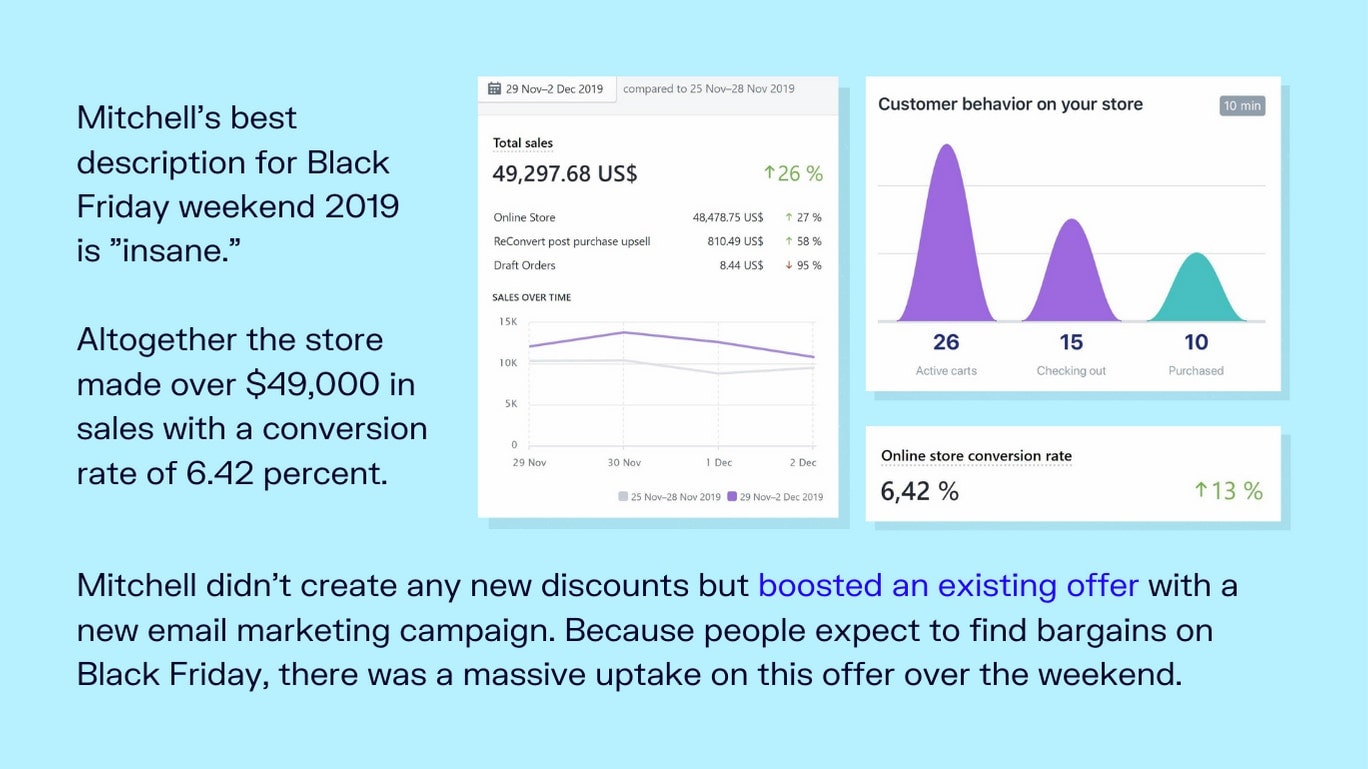
Hitting Pause and Regrouping
At this stage, Mitchell realized the best thing he could do was stop his ads, get things under control, and build a more robust system.
“We did have some problems throughout November and December. The agent promised me that orders done before Black Friday would get there by Christmas, and a lot of orders weren’t. So I did take some time out, just to get everything back [to normal] – like refunding those customers who were disappointed.”
Eager to keep his customers as happy as possible, Mitchell got his virtual assistants (VAs) to focus a lot of energy on customer service. And with customer service under control, Mitchell was able to focus his energy on problems elsewhere.
“I hired some great people from the Philippines through Fiverr, and they were like life-saving actually. They were just making sure every email and every comment got replied to and just keeping customers informed.”
Outsourcing and spending money on VAs is something Mitchell learned while running his first store. And he thoroughly recommends it to others who are scaling stores.
“With the first store, I was scaling without a plan. I didn’t have the system in place. I didn’t have customer service in place, and I couldn’t keep up with the demand. As soon as you are reaching maybe 20 or 30 orders a day, you want to look into getting a VA to help you out. Because customer service is something you can always delegate as long as you have a system in place. Your time could be better spent elsewhere.”
In the end, between Mitchell and his VAs they handled all customer queries and complaints. Although he expected people to be mad that the product was shipping from China, this was almost a non-issue. Additionally, he found that if customers were aware that shipping might take 2-3 weeks, they were generally content to wait, highlighting the importance of being upfront with customers before they buy.
Preparing for Relaunch and Looking Long-Term
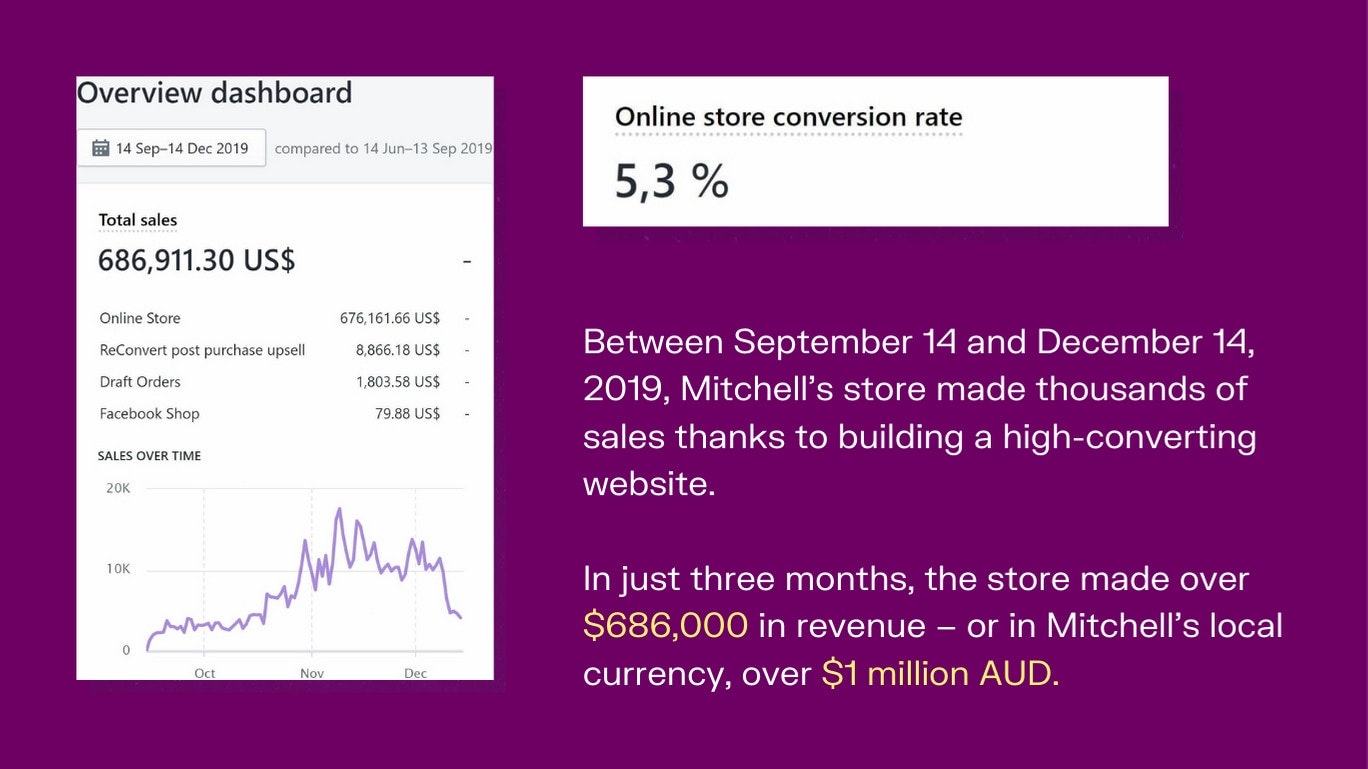
After working through the backlog of orders from November and December, Mitchell could finally turn his attention on setting up permanent changes to help his business long term.
Before pausing ads, Mitchell’s store made over $686,000 in sales in just three months. He knew having robust processes would only set the store up for more success. After months of work he’s now planning to bulk order his product to the United States to help get packages to customers in a more timely manner.
By setting up these systems for his main one product store, Mitchell’s also putting things in place to help future stores. He still has his old home decor store and is also working on a new store.
Ideally, he’d like to get the stage where one of his stores is almost autonomous and can focus on building others, ensuring he always has a stable income.
With such an ambitious plan in mind, it’s clear that Mitchell’s in ecommerce for the long haul. And while he’s already starting to move away from operating under a dropshipping model, he’s thankful for all the skills his dropshipping stores allowed him to develop.
“I think ecommerce is the way forward for a lot of people. There’s a lot of money to be made. I think dropshipping is a good entry into ecommerce, but then I think maybe after two or three years, you want to take it to the next level and build a sustainable business. Once you get confident, you’re like, ‘I have these skills for life.’ Like ‘I’ll always be able to advertise to someone and sell products.’”
Mitchell’s Tips for Beginners

Mitchell’s careful approach has helped his store become an established brand. Soon he’ll be moving onto doing the same for other products. Looking back at his journey, he believes a few things helped him achieve all this.
Have a Good Mindset
Without the right mindset, Mitchell’s sure none of his success would’ve happened. He’s adamant that anyone wanting to make real money or progress with a business needs to have their head in the game.
“I think number one would come down to mindset. Before I found success, I was just [half assing] it. I never went the extra step. It wasn’t until I actually ordered the product to my house. I sent the products to other people, going the extra step that a lot of people don’t do. They just copy and steal videos.”
Write Down Daily Goals
While being an entrepreneur gives you free rein over your day, Mitchell tries to plan his out as much as possible to get the most from his time.
“I would always plan out my day in advance. I’d plan out the day the night before, write down what things I needed to accomplish the next day. That way, you don’t wake up and feel like ‘Oh, what am I doing today? Am I going to do the ads? Am I going to do this?’”
Mitchell’s daily lists mean he works with intention. As a result, he doesn’t waste time and only needs four or five hours a day to get everything done.
“I like to use the Pomodoro technique, where you focus for 25 minutes and then take a five-minute break. For each Pomodoro, I would choose a section or category for my business to focus on. I’m not a workaholic by any means at all. I like to wake up and then go to the gym. Come home. I only work maybe four or five hours a day.”
Reach Out to Others
Being an ecommerce entrepreneur can be a lonely career path. But Mitchell’s found that most entrepreneurs are more than willing to help others out when they can.
One example of this was when he needed help finding a dependable supplier for his store. Mitchell found good supplier who he’s been able to build a relationship with after simply reaching out to a few YouTube dropshippers and asking for recommendations.
Having a Game Plan
Forming a solid business plan is a fantastic way to start your business right. It clearly shows your path forward and is a massive help when you have periods of feeling unmotivated.
“Don’t get me wrong. There have been times like Christmas and January, where I was feeling down. I was not motivated to do anything. I think it is okay to take time out for yourself. You don’t need to grind 24/7 every day of the year. But when you want to put your plan to action, make sure you have a decent plan to start with. And as I said, writing down what I want to achieve tomorrow has been a big thing for me. I’m not sure if other people do that, but that’s how I piece out what needs to be accomplished.”






